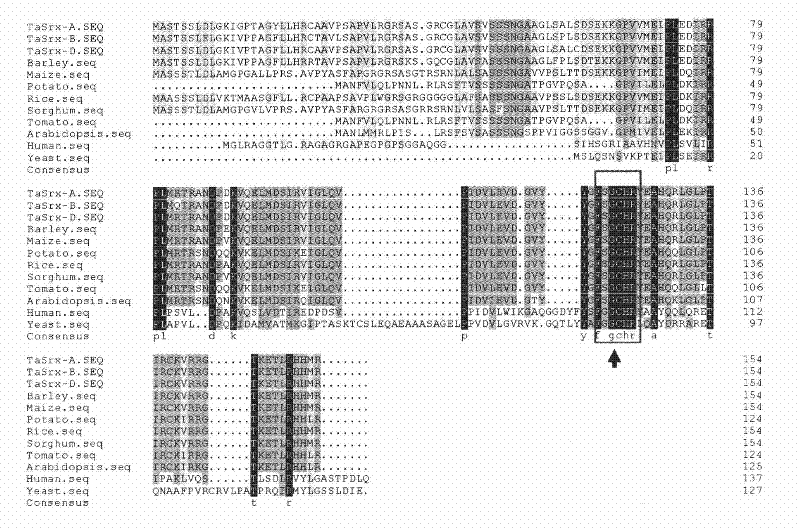Antioxidation-related genes of wheat as well as coding proteins thereof and application thereof
A related protein and anti-oxidation technology, applied in the application, genetic engineering, plant genetic improvement and other directions, can solve the problems of increasing the degree of photoinhibition and decreasing the resistance to photobleaching, and achieve the effect of increasing biomass and promising prospects.
- Summary
- Abstract
- Description
- Claims
- Application Information
AI Technical Summary
Problems solved by technology
Method used
Image
Examples
Embodiment 1
[0064] Example 1: Homologous cloning of TaSRX gene and analysis of gene structure
[0065] All EST sequences of SRX gene were searched through NCBI-Blastn, and three types of full-length EST sequences of SRX gene found in hexaploid wheat (subgenomic component AABBDD) were obtained through alignment and splicing. Design conservative primers at ATG and TGA to clone these 3 copies at the same time, perform PCR amplification in turn, recover the target fragments, connect with TA, transform bacterial competence, culture at 37°C, colony PCR identification to obtain positive clones, positive plasmid extraction, and finally proceed Plasmid digestion identification and sequencing to obtain three copies of the full-length genome sequence. They are compared with Arabidopsis and rice SRX genes (i.e. AtSRX and OsSRX) as attached figure 1 Shown.
[0066] The specific steps are as follows:
[0067] The primers used were 5'-ACGAATGGCGTCGACCTCGAGCTT-3' and 5'-CATCGCTAACCACCAATTCATCGCATAT-3'. PCR a...
Embodiment 2
[0071] Example 2: Cloning of TaSRX gene cDNA sequence and protein sequence prediction and comparison
[0072] The cDNA of XY54TaSRX was cloned with the same primers as in Example 1. PCR amplification reaction conditions: 95°C pre-denaturation 5min; 94°C 40s, 68°C 1min, 33 cycles of two-step method; 68°C 7min. Reaction system 50μl: 10×PCR reaction buffer 5μl, LA-Taq enzyme (Takara) 0.5μl, 100ng Xiaoyan 54cDNA, 2.5mmol dNTP 4μl, 5μmol primer each 1μl, add sterilized double distilled water to 50μl. The PCR products were subjected to agarose gel electrophoresis to purify the target TaSRX cDNA fragments. Eppendorf BioPhotometer determined the concentration and used for digestion, ligation or storage at -20°C for later use. The purified TaSRX cDNA fragment was ligated with pGEM-T Easy vector and transformed into E. coli DH10B by heat shock. Colony PCR (primers are the above-mentioned amplification primers) identify positive clones, and extract positive clone plasmids. The specific m...
Embodiment 3
[0081] Example 3: Determination of TaSRX Gene Copy Number-Fluorescence-labeled DNA Fragment Analysis Technology
[0082] Using fluorescently labeled conservative primers across the second intron (only the 5'end of the upstream primer is labeled with D4 fluorescent label, Takara) amplify Xiaoyan 54 (subgenomic component is AABBDD), Jing 411 (subgenomic Divided into AABBDD, the seeds come from the laboratory of Academician Li Zhensheng, Institute of Genetic Development, Chinese Academy of Sciences 14 , DNA comes from leaves at the seedling stage), Langdon (subgenomic component is AABB, seeds are purchased from Graingene in the United States), Urartu wheat (subgenomic component is AA, seeds are purchased from Institute of Crop Science, Chinese Academy of Agricultural Sciences), Aegilops (the subgenomic component is DD, the seeds were purchased from the Institute of Crop Science, Chinese Academy of Agricultural Sciences) genomic DNA (refer to Example 1 for the extraction method), and ...
PUM
 Login to View More
Login to View More Abstract
Description
Claims
Application Information
 Login to View More
Login to View More - R&D
- Intellectual Property
- Life Sciences
- Materials
- Tech Scout
- Unparalleled Data Quality
- Higher Quality Content
- 60% Fewer Hallucinations
Browse by: Latest US Patents, China's latest patents, Technical Efficacy Thesaurus, Application Domain, Technology Topic, Popular Technical Reports.
© 2025 PatSnap. All rights reserved.Legal|Privacy policy|Modern Slavery Act Transparency Statement|Sitemap|About US| Contact US: help@patsnap.com



